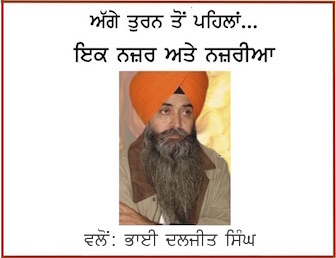Articles/Opinion
Indian Media’s Role during Sikh upsurge of 1980-90s in Punjab Questioned
April 30, 2014 | By Jaspal Singh Sidhu
A discussion report on book: ‘Embedded Journalism, Punjab’
Journalists and historians gathered to discuss latest book on the role of media during Sikh agitation observed that the policies that the ruling Congress Party at the Centre pursued in early 1980s had disastrous results in Punjab. It saw bloodshed leading to Operation Blue Star and caused pogrom of Sikhs in 1984. Not only that Prime Minister Indira Gandhi lost her life, the Congress too lost its stature of the single largest party that had uninterruptedly ruled over the country for three decades after Independence.
A lot has been written on the subject but, surprisingly, very little is found on the role of media during that period of India’s history. A larger section of media had extended an uncritical support to the then Congress government. That section unabashedly acted as a ‘propaganda arm’ of the government by putting a lid on state terrorism, branding political dissidence as anti-national activity and building public opinion in favor of the security forces that ruthlessly operated against the non-combatant populace.
![Embedded Journalism in Punjab [Book]](http://www.sikhsiyasat.net/wp-content/uploads/Embedded-Journalism-in-Punjab-189x300.jpg)
Embedded Journalism in Punjab [Book]
A book, ‘Embedded Journalism, Punjab’ edited by Jaspal Singh Sidhu and Anil Chamadia, which presents a critique of the role of the media, was the subject of discussion at a gathering in Chandigarh recently. Perhaps, for the first time, half a dozen senior journalists narrated their harrowing experiences of how the government of the day forced reluctant journalists to embed with authorities by resorting to tactics like arm twisting, which-hunting, transfers and other punitive actions against them while covering the Punjab trouble for various media outlets. The interaction was also joined by several others, including historians, Ajmer Singh and Gurdarshan Singh Dhillon. Most of the speakers underlined the complicity of the management of media outlets with the State as they created a fiction of ‘law and order’ that led to the projection of a distorted picture of Punjab in general and Sikhs in particular. National media labeled political dissidents as ‘extremists, terrorists, fundamentalists, fanatics, secessionists’ and generated a mental association between ordinary Sikhs and terrorists by pre-fixing the word Sikh to these.
The book draws its title from the Western theoretical premise of ‘embedded journalism’ which was coined to express the orchestrated media coverage managed by the US and its NATO allies during the invasion of Iraq in 2003. The book puts in one place, hitherto scattered and largely unnoticed, critical writings on the media that appeared in 1980-90s. These media critiques were penned by celebrated writer late Patwant Singh, Human Rights activist late Ram Narayan Kumar and Pritam Singh from Oxford. The book also has two unpublished government sponsored reports. One is a study of the media in Punjab by the V.G Vergese Committee in early 1990s and the other is an analysis of the entire Punjab media, as it existed in early 1980s, by Tirlok Singh Deep, a New Delhi-based journalist.
Speaking on the control of media by the establishment, former editor of Punjabi Tribune, Sidhu Damdami, said that earlier there was a widely held view that public sector broadcasters, AIR and Doordarshan, were restricting the free and fair flow of information and it would be corrected with the coming up of private media operators. But it has turned out to be an illusion. What actually happened is the other way round. The private media traded, controlled and suppressed information to suit the interest of their corporate masters. Sidhu, who worked in AIR/Doordarshan and later headed various TV channels, recollected that there was a long list of dos and don’ts in AIR and Doordarshan which debarred the journalists working there from writing, speaking or presenting any text critical of the government. “Unfortunately, now, journalists working for private media outlets are more muzzled than AIR and DD journos. They are virtually enslaved to the verbal dictates and unwritten guidelines of the organisation and are shown the door if they dare to digress.” By narrating his own experience of an interview with Punjab Chief Minister for AIR in the 1990s, he brought out how some media persons were purveying information and gathering intelligence for political persons.
Sukhdev Singh, who had reported for the Tribune in Chandigarh for several years, said that in 1980s the establishment had divided working journalists of main media outlets in Punjab in three categories– red, blue and white– as per their degree of disposition for journalistic independence and pliability for collaboration. As part of media management, some senior journalists from Chandigarh were taken to New Delhi by the authorities for a ‘cup of tea’ with Prime Minister Indira Gandhi.
Sukhdev Singh revealed the Tribune did not use his copy on Akali Dal’s decision on November 4, 1981 pertaining to holding demonstration at Asiad games in New Delhi to convey to the world about New Delhi’s ‘discriminations’ against the Sikhs and Punjab. “I was especially deputed to cover that Akali meet at Amrtisar . But instead of using my copy, Tribune preferred to use UNI copy which had distorted the news to suit New Delhi policies” .
The UNI copy put Akalis in confrontation to the Centre as it said that ‘Akalis have decided to disrupt Asiad’. That news provided an excuse to the then Haryana Chief Minister Bhajan Lal to depute his police in a big way to search, frisk and humiliate the Sikhs coming to Delhi from Punjab through all road and rail links passing through the state. That sort of inspired reporting in the media poisoned common Indians against the Sikhs in far off areas too, as was evidenced in protests in Kerala against the Sikh players playing in the Indian hockey team in those days.
Sharing his experiences, octogenarian journalist Dalbir Singh, who as staff reporter of the Tribune in Amritsar covered the Sikh-Nirankari clash of April 1978 sparking a shift in Sikh politics, said the media invariably contributed to the Punjab trouble by indulging in acts of simulation and dissimulation.
Former Indian Express staff reporter ,Chanchal Manohar Singh narrated that Punjab police got almost every cold-blooded killing of the Sikh youth projected as ‘police encounter’ in the pliable media. “Once I reported some gory excesses of police action which resulted in killing the Sikh youths in Tarn Tarn in 1990s. Next day, K.P.S. Gill dashed to Amritsar from Chandigarh; hauled me up in the hurriedly convened press conference; and pointedly asked me why I had filed that story. He was such a terror in those days that no other journalist stood up in support of me or for ‘the freedom of the press’. I told Gill that your officers are planting fake news on the media every day, so you are finding it difficult to digest one truth that has been reported in the press. Gill got incensed over my reply in front of all, lost his balance and left the conference hall, raking up speculation among my media colleagues that ‘my end was imminent.”
Relating another incident, Chanchal Manohar Singh said, “a Sikh youth was arrested by the Tarn Tarn police after the accused had eloped with a young married woman, carrying a year old daughter. The police presented the accused and the woman before the media persons at a press meet, convened by SSP Ajit Singh Sandhu. The SSP insisted that the youth was ‘raping’ the girl child which I questioned.The police officer got enraged to the extent of using foul language against me but other media persons, including my newspaper truthfully reported what was planted by the SSP as a part of police’s disinformation campaign. Next day, when I lodged a protest with my editor for using the news agency copy instead of mine, I was transferred to Patiala from Amritsar”.
Summing up his observations, Manohar Singh said, “the journalists were posted and transferred at the bidding of the Police officers and pliable journalists willing to carry the police propaganda were heftily rewarded, police provided them all facilities and their assets grew at an astronomical speed”.
“ If it is mandatory for the IAS/IPS to supply information about their assets, and politicians have to declare their assets on eve of the elections, why should the media not be made accountable?”, Singh added.
Sikh historian Ajmer Singh questioned that “how come some media outlets, particularly language newspapers, are describing as ‘Shaheed’ (martyred) the security forces jawans killed in skirmishes with militants in Jammu and Kashmir and other disturbed areas? Such characterization is a socio-political act, clearly beyond the domain of media reporting”, he said.
Questioning the branding of Sikh militants as ‘terrorists’ and those of Kashmiris engaged in similar acts in Jammu and Kashmir as ‘militants’, Karamjit Singh, who has worked at senior positions in Punjabi Tribune, said: “the Tribune management had instructed us to use ‘atankwaadi’ and ‘dahshatgard’ for the gun-toting Sikh youth instead of the word ‘Kharku’ (militant) in Punjabi .We, however, reached at a consensus to use less-devilish word ‘garam-daliye’ for them.”
The Jalandhar Mahasha newspapers used to project the Sikh militants as ‘devils’. Citing an example from the Mahasha press, he said a report referring to the killing of ‘general’ Labh Singh by police in late 1980s maintained that ‘his body was lying in a field and a vulture descended on it but immediately flew away as flesh of the terrorist was not palatable even to the scavenger’.
Summing up the discussion, Anil Chamadia, co-editor of the book who also heads the Media Studies Group (MSG) in Delhi, urged the participating journalists to pen down their valuable experiences on the issue and his centre would publish them. Their experiences would help intelligentsia and analysts in delineating media affairs.
Expressing dismay over the state of journalism in the country, Chamadia said his team had collected the information through RTI that only a small groups of pliable ‘experts’ have been called for staging a façade of ‘conducive discussions’ by the public sector and private media outlets and a set of select columnists have been writing for all English and regional language newspapers.
Referring to raging corruptions in a section of mass media, Chamaria asked the participants to collect information about the assets amassed by some journalists in Chandigarh as authorities had pampered them during the Punjab trouble and they will put that details on Media Studies Group’s website.
About author: Jaspal Singh Sidhu retired as Special Correspondent of United News of India (UNI) New Delhi in December 2008, since then, writing on media, political affairs and environment issues.
To Get Sikh Siyasat News Alerts via WhatsApp:
(1) Save Our WhatsApp Number 0091-855-606-7689 to your phone contacts; and
(2) Send us Your Name via WhatsApp. Click Here to Send WhatsApp Message Now.
Sikh Siyasat is on Telegram Now. Subscribe to our Telegram Channel
Related Topics: Embedded Journalism, Jaspal Singh Sidhu




